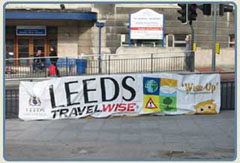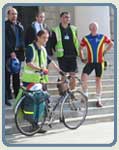


 



  
|

Taxonomy and description
Terminology
Mechanisms for Change
Technology
 Terminology Terminology
Individualised marketing campaigns to reduce car use are a targeted form
of public awareness campaign. Public awareness campaigns are programmes
designed to increase individuals' awareness of alternatives to car use.
Campaigns can range from blanket advertising to individualised marketing
projects. It is also possible to run both simultaneously, such that the
advertising supports the individualised marketing.
There are a number of steps on the way to achieving a reduction in car
use:
1. Making car users aware of the need to reduce car use,
2. Making drivers aware of the options available to them,
3. Facilitating change in travel habits, and
4. Encouraging the maintenance of new travel patterns.
 It
should also be noted that having taken on board the need to change and/or
actually made a change, habitual drivers can relapse into old ways of
thinking and behaving. Relapse may occur if individuals do not feel supported,
they feel they are making changes in isolation, the alternatives they
are using do not adequately meet their needs or involve too much effort,
or they perceive that the need to use cars less has receded. Such relapses
may not be permanent. Individuals can cycle through the stages of change
several times. Often the change will be longer lasting each time until
it becomes habitual. It
should also be noted that having taken on board the need to change and/or
actually made a change, habitual drivers can relapse into old ways of
thinking and behaving. Relapse may occur if individuals do not feel supported,
they feel they are making changes in isolation, the alternatives they
are using do not adequately meet their needs or involve too much effort,
or they perceive that the need to use cars less has receded. Such relapses
may not be permanent. Individuals can cycle through the stages of change
several times. Often the change will be longer lasting each time until
it becomes habitual.
Mechanisms that can be useful at each stage are outlined in mechanisms
for change.

Mechanisms for Change
| Stage of Change |
Mechanisms |
| Raising awareness of need to reduce car use |
Blanket advertising re negative impacts of car use.
This could include television, radio, billboard advertising as well
as space on the back of buses and leafleting. |
| Making drivers aware of the options available to them |
More targeted advertising of alternatives available.
This might include an advertising campaign for walking, or promoting
bus services along a corridor for example. New alternatives, incentives
and/or disincentives can be introduced and advertised at this stage. |
| Facilitating change |
Highly targeted material, ideally at the individual
level. New alternatives, incentives and/or disincentives if not already
introduced. |
| Maintenance |
Targeted at those who have already changed, ideally
at the individual level. Letters of encouragement & reminder, progress
reports to show how much change others have made and further incentives
are ideal. |
The first two stages are unlikely to result in substantial change in
levels of car use, although one or two innovative and/or already environmentally
conscious individuals may change at the first stage and a few more at
stage two. To achieve more substantial change, more targeted marketing
is needed to help those with no concept of using alternatives to the car
make changes in their travel habits. The most effective way of doing this
is to identify individuals who are willing to make changes to their travel
habits, find out what journeys they make and provide information on specific
alternatives available for those journeys. This process is known as individualised
marketing to reduce car use. The individualised marketing can promote
other measures, which provide alternatives to solo driving, e.g. ride
sharing or introduction of a guided bus.
Individualised marketing campaigns to reduce car use can be the sole
constituent of a travel awareness campaign and are often referred to as
a travel awareness campaign in these situations. Other individualised
campaigns are branded by those running the campaign, e.g. Travel Blending®
run by Steer Davies Gleave consultancy and Travel Smart® co-ordinated
by the Western Australia Metropolitan Transport Department. Travel Smart®
also includes educational programmes in schools and work with employers
and community groups to reclaim streets and improve the environment. Additionally,
Travel Smart® has links into national programmes such as the Smogbusters
environmental campaign. Similarly in the UK the term Travel Wise®
is an umbrella title for work to reduce car use. Hence, a Travel Wise
campaign could include an individualised marketing project, advertising
of the negative impacts of car use and cycling promotion, for example.
Technology
An individualised marketing campaign is not dependent on technology. However,
it can aid the collection and processing of an individual's travel data.
Travel diaries are normally used to collect data on individuals journeys.
In most examples, these are paper diaries, but it would be possible to
use laptops, palm pilots or the internet. It may also be possible to use
global satellite positioning (GPS), but there are no examples of this.
Once data is collected, it is necessary to identify journeys an individual
is making that it would be possible to undertake by public transport,
walking or cycling. It is then necessary to check personal details such
as mobility problems to ensure the recommended alternative is suitable
and find the appropriate public transport journey itinerary. For monitoring
purposes, it is necessary to record details (mode, distance and number
of journeys) of journeys an individual is making before and after recommendations
are made, for comparison. Clearly all of this is possible by hand, but
it is extremely time consuming. Thus, use of a database is recommended.

|




